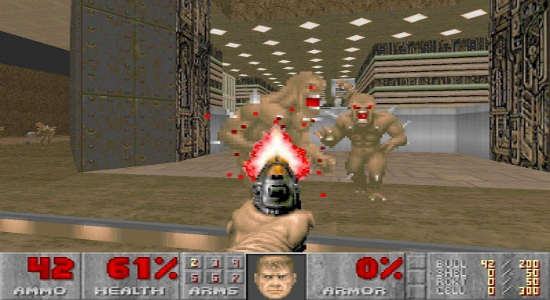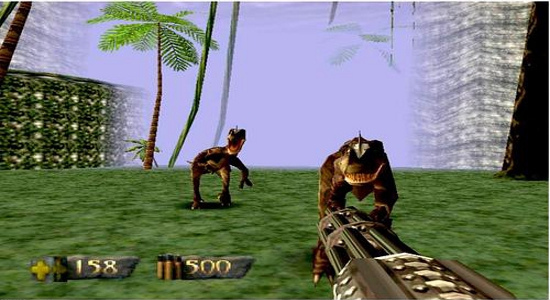This post has not been edited by the GamesBeat staff. Opinions by GamesBeat community writers do not necessarily reflect those of the staff.

Over the last two decades, First-Person Shooters have become a prime example of maturation in video games as a medium. Having always served everything to players from the perspective of a main character, certain conventions were defined by the initially crafted offerings of titles in the genre. These rules, established in a certain evolutionary cycle, became the standard until something seemingly insignificant occurs and profoundly revitalized the genre.
Despite being the initial FPS, Wolfenstein 3D would quickly be surpassed by Doom, which embraced by mainstream popular culture, would spawn an entire genre of games. Doom set the modus vivendi of fulfilling the role of a character by experiencing the story from their point of view and utilizing of gratuitous amounts of ordnance to complete the prescribed narrative, becoming the underlying blueprint of every FPS in the process. However, despite being a genre many gamers can relate to and many, if not all are aware of; there has always been a steady stream of revolutionary iterations that continue to keep us all coming back for more.

Although purporting many basic traits of a standard FPS, 3D Realms’ Duke Nukem 3D exceeded expectations by adding to the groundwork laid by Doom. The silent Space Marine was replaced by a testosterone-driven, outspoken badass who couldn’t wait to spout out another quip to recently slaughtered enemies and patronize strippers. Needless to say, Duke found a following.
Replacing the standard Shotgun and Rocket Launcher with creative weapons like The Shrinker served to give the game as much personality as the main character. The addition of allowing players to put boot to face when it came to doors and close encounters with enemies bridged the FPS gap. For many, the torch had been passed.
Unfortunately for those old enough to remember, bland reproductions of precedent setting titles eventually became the order of the day. That is, until three titles appeared on the Nintendo 64 that have since gone down in history as pushing the boundaries of their genre ever outward.

Goldeneye, proffering definitive missions, challenging difficulties and lauded multiplayer is still the reason many people continue owning an N64 when more contemporary offerings abound. Soon after, it would be Perfect Dark, the spiritual successor to Goldeneye. Nonetheless successful for streamlining and including features that had been left out of its successor, PD turned many traits found in Goldeneye up to eleven. Sims, slews of multiplayer options and even campaign co-op would see the game garner a sequel on the Xbox 360 as well as a port to Xbox Live Arcade years later. But, where Goldeneye and Perfect Dark would find a contemporary in Modern Warfare for their multiplayer capabilities, Turok: Dinosaur Hunter could be related to Bioshock for offering an engrossing single player experience.
The original Turok was an exceptionally unique experience for the time it was released. Lacking any multiplayer whatsoever, the developers instead focused on crafting a visceral, entertaining adventure that is yet to be repeated in the franchise, which has long grown stale. Unique weapons like the Chronoscepter and the aurally gratifying Minigun in addition to memorable enemies and bosses assisted in creating a cult following for the title. But much like current events, accessibly addictive multiplayer easily eclipses a brilliant solo experience.

As technology advanced, so did the genre that allowed players the most flexibility with feeding the primal urge to kill everything in sight. Games released on the PlayStation 2 and GameCube would offer relatively interesting experiences. But, it would be a title from a small, Chicago-based developer that would supersede the periphery of then-current design and rewrite many of the original commandments of FPS games.
Halo was released as a launch title with the first Microsoft gaming console in November of 2001. Turning what many believed would be one of the software developer’s biggest blunders into a definitive presence in gaming culture was no easy feat. While the narrative may not have been the most original and a minutia of flaws could be nitpicked, Halo changed a great deal of things.
Removing the ability to carry every weapon in sight, players were pared down to only being able to carry two. Seemingly an insignificant design move, but when sacrificing a specialized weapon for one that fills multiple roles, gamers tend to notice. Additionally, the AI was significantly improved over other available games, which usually was only noticed on Legendary. By the time many noticed it however, they had been stuck with a plasma grenade from a wily Elite or Grunt. Moreover, as a system exclusive franchise, Halo seemingly comes up more often in flame wars than almost any other title.

After all, if it wasn’t memorable, it wouldn’t have achieved the position it has amongst creators. When a new game possessing FPS qualities is announced, one of the first marketing phrases touted is, “Halo-Killer” and it has been that way since Guerilla and Sony unveiled Killzone. Since then, Bungie’s creation has set the bar for this evolutionary cycle of games, at least until something equally impressive and uniquely innovative is produced.
That doesn’t go to say innovative titles haven’t been released since Halo, they just haven’t succeeded in breaking the evolutionary wall. While Half-Life is aptly touted as a "Thinking Man's FPS" along with the Killzone trilogy. which is going to go down in history as one of the most amazing series to ever grace Sony-made consoles. It should be noted that despite their graphical beauty, even with the impending use of 3D, they don't really break any established molds. Graphics and gameplay mechanics unfortunately do not go hand in hand when delineating what makes a great FPS – just ask anyone who played Crysis.
Doubtlessly though, First-Person Shooters will continue to grow and change as long as game consoles exist for them to be played on. Halo: Reach and Killzone 3 are just two notable beasts in the current genus that will constantly shift to match the visions of those who create them along with appealing to those who want to play them. Much like television and film, video games have come a long way as an artistic medium, conveying new stories and interesting, crafted experiences. However, as they have a long way to go and so much more to show us, realistically we’re still only witnessing the beginning.
